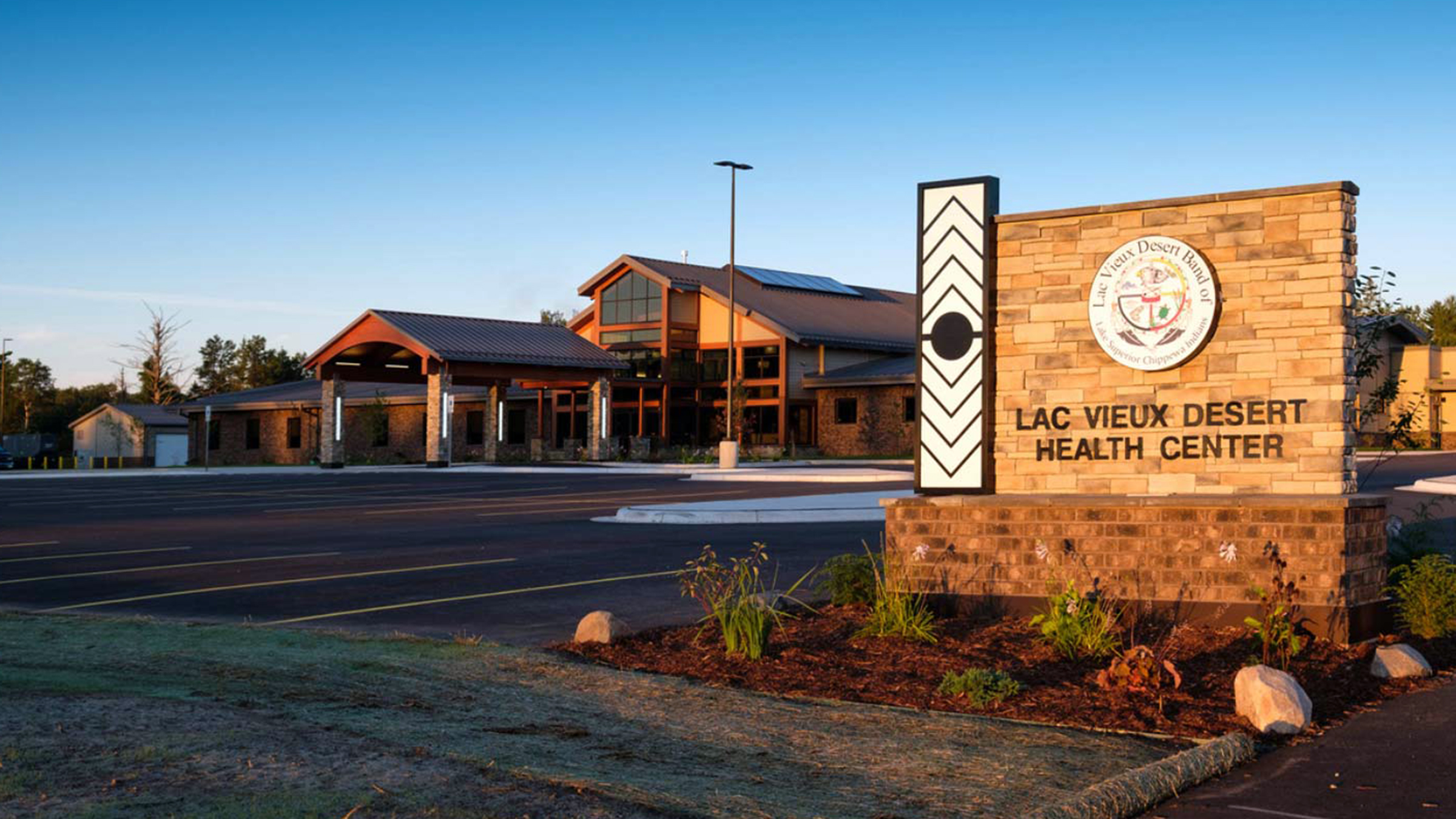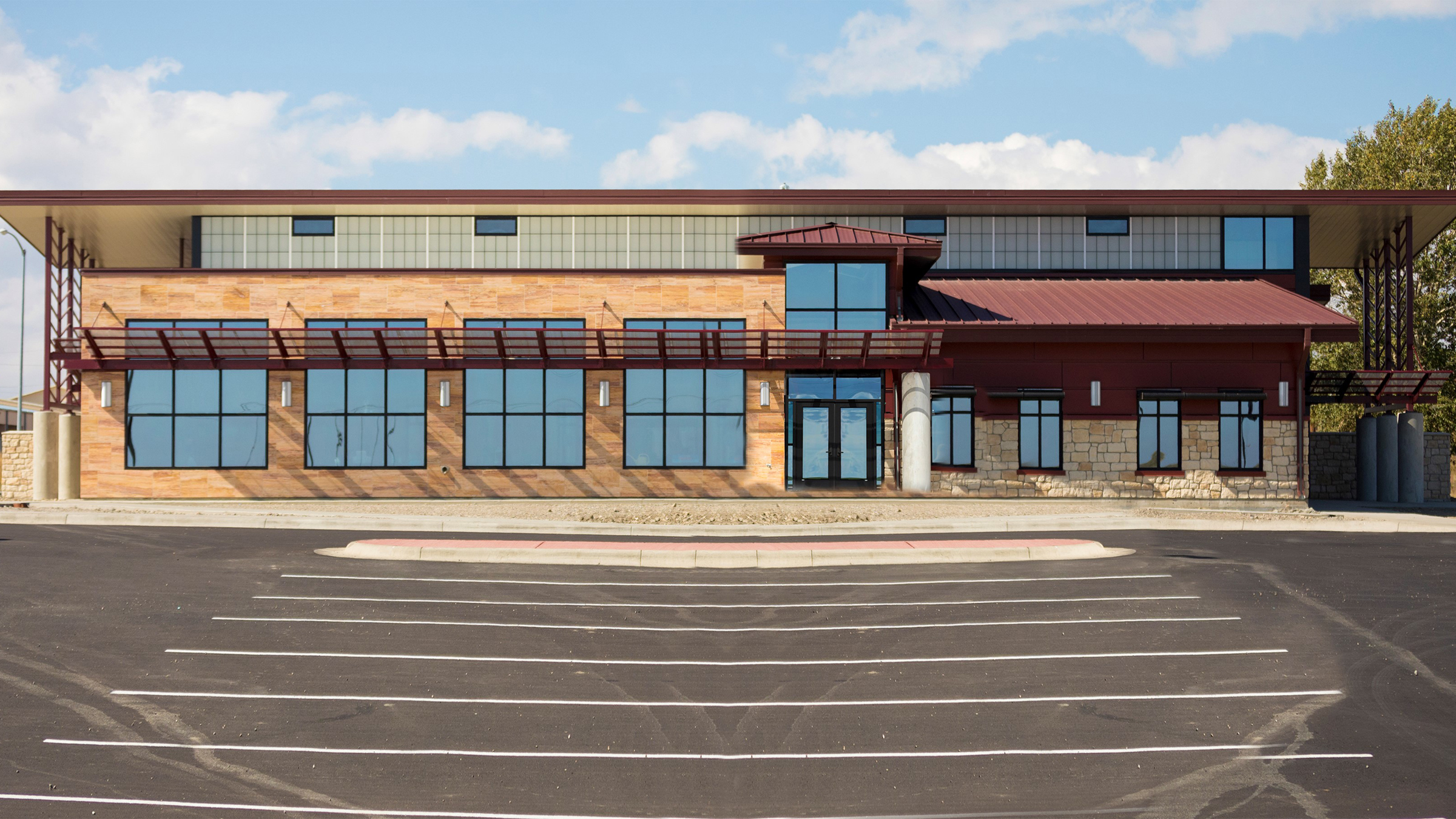Nine years ago, the Lac Vieux Desert Band of Lake Superior Chippewa Indians wanted to build a modern health center. In addition to providing their community on Michigan’s Upper Peninsula with comprehensive medical and dental care, the center was expected to create jobs on the reservation and bring in business from surrounding areas. But the band needed a way to finance the project. A conversation with a neighboring tribe pointed in a helpful direction: that tribe had recently financed a dental clinic through a federal tool called New Markets Tax Credits (NMTCs).
However, pursuing NMTCs for the health center wasn’t easy. The process required extensive stakeholder education, conversations with several iterations of the tribal council, and hundreds of hours of legal counsel. Ultimately, the tribe’s efforts succeeded. NMTCs covered most of the Lac Vieux Desert Health Center’s $13.5 million project cost. Since the center opened in 2016, band members have accessed medical and dental services from a state-of-the-art facility, and the clinic has generated revenue for the tribe by attracting non-tribal patients.
Was it worth it? “Of course it was,” said Sadie Valliere, a health services administrator at Lac Vieux Desert Health Center. But the application process brought challenges.
Valliere was one of 19 NMTC practitioners the Center for Indian Country Development (CICD) recently interviewed to shed light on barriers to participation in the NMTC Program in Indian Country and potential solutions. CICD provides research and resources to deepen understanding of how federal financing and tax incentives advance the prosperity of Native economies.
With an initiative underway by the NMTC Program to encourage Native participation, the frontline perspectives of the practitioners we interviewed provide valuable insights.
What NMTCs are and why they matter for Indian Country
Established by the U.S. Congress in 2000, the NMTC Program is designed to attract private investment to low-income communities. Under the program, the Community Development Financial Institutions (CDFI) Fund at the U.S. Department of the Treasury awards NMTC allocations to certified financial intermediary organizations called Community Development Entities (CDEs), which can include banks, loan funds, and other qualifying organizations with a primary mission to serve low- and moderate-income persons or communities. CDEs, in turn, sell the tax credits to private corporations or individuals in exchange for equity investments in those same CDEs. The CDEs then use the proceeds to make qualified investments—such as business loans or equity investments—in low-income communities.
In Indian Country, the program offers tribal nations a way to address barriers to generating revenue and capital for economic development, such as constraints on their taxation and bonding authority. Tribes and other organizations that serve tribal interests can participate in two ways. They can apply to become certified as a CDE and seek NMTC allocation authority, or they can pursue NMTC financing as a qualified low-income community business. It’s an opportunity that’s currently underutilized—and, as we heard in our interviews, there are reasons for this.
Previous CICD research has found that although the share of NMTC investments for tribal entities has increased, tribal entities’ involvement in the program remains low. For every $100 in NMTC investments involving non-tribal entities, tribal entities receive less than $1, even though a disproportionately high share of census tracts eligible for NMTC investments are located in tribal areas. Further, among projects within Indian Country, participation is concentrated among a small number of tribes. If program participation were on par with the need in Indian Country, tribal entities would likely receive a greater share of NMTC investments, and those investments would likely be distributed across more tribes.
Barriers to accessing NMTCs in Indian Country
In 2022, CICD conducted 14 interviews with a total of 19 practitioners on the front lines of NMTC projects in Indian Country to understand barriers to program participation—and potential solutions. These interviewees, recommended by CICD partners, included representatives from six tribes and three banks, practitioners from five CDEs (including two non-Native-owned CDEs), and a consultant working with NMTC projects in Indian Country. Although the interviewees were not a generalizable sample, their perspectives offer instructive insights.
Barrier theme 1: The competitive nature of the application process favors experienced CDEs—to the detriment of emerging CDEs
Many interviewees observed that the NMTC Program is highly competitive, with substantially more applicants than NMTC allocations to award. In their view, the criteria used to evaluate applications favor established CDEs with long track records. For example, applicants benefit from demonstrating five consecutive years of successfully providing products and services similar to the qualified investments the CDE would provide via the NMTC project. This poses a barrier for emerging tribal entities that compete against more-experienced and better-resourced applicants, such as large financial institutions.
An interviewee from a Native-owned CDE described four unsuccessful attempts to apply for NMTC allocations—an outcome that, in their view, reflected their entity’s lack of a proven track record. “Even if you have projects in the pipeline, if you don’t have the needed track record, you won’t get an allocation,” they said.
Barrier theme 2: Program rules are complex, and compliance can be costly
Applying for and—if successful—managing NMTCs is costly and complex, according to our interviewees. CDEs often pay for outside consultants, lawyers, and accountants to help them with the application process. Those whose applications succeed need to establish an investment infrastructure and monitor program compliance. As a result, many small CDEs—including Native-owned CDEs—refrain from applying for allocation authority.
In one example of an application expense, CDEs may pursue formal impact studies to demonstrate their projects’ potential benefits, such as creating jobs and stimulating spending in local industries. Evidence of anticipated outcomes can provide a leg up in the application process, but pursuing this evidence can be costly, requiring the help of a third-party consultant.
Identifying a pipeline of promising projects can also boost an application, but this, too, requires resources. In the words of a representative of a Native-owned CDE, “You need to secure a strong pipeline of deals and a solid exit strategy for those deals at the end of the compliance period, which can make it difficult. There’s a lot of information-gathering, and at our tribal government level, this data is not inherently available within our databases and records.”
Speaking to costs successful applicants experience, the NMTC team at one non-Native-owned CDE described how legal bills for NMTC transactions can add up quickly. “For a $10 million simple-structure deal, there will be $200,000–$250,000 in legal bills,” a team member said. “And as the deals get more complex, the legal fees go higher from there.”
Barrier theme 3: Investment incentives and perceived risks can disadvantage smaller projects
Investors seek to maximize returns and minimize the risks of their investments. When it comes to the NMTC Program, this can manifest in a preference for larger projects with substantial projected impacts, as well as projects in well-resourced communities with supportive infrastructure. For an under-resourced tribe with a small project, this can make it hard to attract the necessary support.
Barrier theme 4: Partners often lack understanding of how to work within Indian Country and in ways that respect tribal sovereignty
Partners structuring NMTC deals in tribal areas often have limited understanding of economic development in Indian Country, according to our interviewees. This includes limited understanding of how to work in ways that honor tribal sovereignty. These comments from interviewees align with a CDFI Fund study that found that lenders are often unwilling to extend credit in Indian Country because of “uncertain tribal commercial laws and regulations and the absence of an independent judiciary.”
Speaking to one consideration unique to tribal areas, a bank executive observed, “Parties involved need to get a better understanding of the necessity and the impact on tribes of having to sign a sovereign-immunity waiver.” The sovereign status of tribes means that tribes are responsible for organizing their legal infrastructure, which has substantial implications for jurisdiction, collateral, and dispute-resolution practices that lenders must be aware of when working with a tribe or tribal enterprise. In developing NMTC projects, tribes may wrestle with whether to waive sovereign immunity in limited ways to promote outside investment, and investors may consider alternative dispute-resolution mechanisms, such as binding arbitration.
Additional challenges
Our interviewees described additional challenges, including tribes’ lack of collateral. Representatives of a non-Native-owned CDE described how smaller tribes can lack the general funds needed to front a substantial portion of the project cost. In the words of one these representatives, “Due to a lack of collateral, seldom do you see an outside investor make a loan into a New Markets transaction on Native land.” Interviewees also mentioned that deals in Indian Country can require additional approvals—such as from the Bureau of Indian Affairs or U.S. Department of Agriculture (USDA)—that slow the process and cause uncertainty for partners.
Frontline perspectives on potential policy considerations
Interviewees offered several potential solutions for overcoming these barriers. Perhaps what their observations made most clear was that there are no easy answers. The considerations for any given solution are—like the NMTC Program itself—complex. Perspectives on the merits and risks of each solution varied, but taken together they provide important insights that can inform efforts to reduce participation barriers.
Solution theme 1: Create an allocation set-aside for tribal entities
Many of our interviewees felt a potential solution was to create an allocation set-aside for tribal entities. The idea is to ensure that tribal communities and tribally focused CDEs receive a greater share of these valuable tax credits.
Speaking to this potential solution, a representative from a Native-owned CDE pointed to success with set-asides for tribal investments in housing: “We’ve found that when a state has a set-aside specifically for tribes, the program has much better outcomes than investments where the state gives points. If we want NMTCs to be used more for minority groups or tribal CDEs, then set-asides are the way to go.”
Even though our interviewees generally supported the idea, they made clear that establishing a set-aside would need to be done thoughtfully. For example, some expressed that guardrails would need to be in place to prevent groups outside the intended audience from taking advantage of the set-aside. And even with a set-aside, resources would still be needed to support the administrative and compliance expectations associated with an allocation.
Solution theme 2: Change the NMTC Program into a federal grant program
Some interviewees suggested a change to the overall program structure: shifting NMTCs from federal tax credits to federal grants. Proponents felt that transitioning to a grant program would reduce barriers, whereas others expressed concern that such a change would bring additional challenges.
Those in favor of a federal grant structure argued that grants offer a more familiar process to tribes. A partner involved with a tribal NMTC project observed, “Tribes are comfortable with and accustomed to grants. Grants are less scary than the current program. Most tribes have the capacity internally to [manage] grants. The more you could move it to grant funding, you’d see an immediate increase in success.”
Proponents also expressed that a grant format would help ensure most of the dollars make their way to CDEs. Investor demand for NMTCs fluctuates, which influences the price investors pay for the credits. The U.S. Government Accountability Office has found that even when demand for NMTCs was highest, credits sold for considerably less than the tax expenditure, reducing the amount of subsidy that made its way to CDEs. One tribal representative observed, “We’re not getting shortchanged by an investor when we apply for grants. There are a lot of people picking pieces off NMTCs [such as accountants, lawyers, and brokers]. That just takes money away from the end user.”
Other interviewees voiced concern that changing NMTCs into a federal grant program would remove what they perceive as significant advantages of private sector involvement. As one banker put it, “How will the grant program make up for the loss of the capital that comes in from additional investment or debt?”
According to others, private sector involvement also introduces valuable vetting into the process. In the words of another banker, “Private sector involvement ensures that resources are put toward projects that [need] it. As bankers, we’re trained as risk evaluators and risk managers. We don’t always get it right, but we collectively think about project feasibility and performance in the marketplace.”
A couple of interviewees offered compromise solutions, such as developing a companion grant component to the existing tax credit program. A representative of a Native-owned bank offered, “There could be a grant component, like how the USDA Community Facilities [Programs have] direct loans or guarantees but also [allocate] grants into projects.”
Solution theme 3: Offer priority points to minority- or Native-owned CDEs that apply for NMTC allocations
NMTC applicants are encouraged to pursue innovative investments, including investments in Native communities, but they’re not rewarded for these choices in the initial application scoring. Rather, this consideration factors later in the application-review process, affecting the size of the allocation, not whether the allocation is awarded in the first place. To address this, some interviewees recommended assigning priority points for investment in Native communities during the initial application review. But to interviewees with broader concerns about how application scoring may disadvantage emerging CDEs, this solution didn’t go far enough.
Solution theme 4: Direct the CDFI Fund to explore options for providing minority-owned CDEs additional training on accessing the NMTC program
Some interviewees felt that providing minority CDEs with additional workshops on how to apply for and use NMTC allocations would provide valuable training and peer support. To others, this wasn’t the right priority. In their view, additional training wouldn’t address barriers associated with the application process, such as how different aspects of the application are scored and the need to establish a track record. A representative from a non-Native-owned CDE asked, “Is spending taxpayer dollars on capacity-building a good use of resources as opposed to addressing other problems with the NMTC Program?”
And perhaps that question gets to the crux of the issue: What are the greatest leverage points for making the NMTC Program more accessible to Indian Country?
Translating stakeholder experiences into solutions
The CDFI Fund recently launched an NMTC Native Initiative to encourage greater participation by Native entities and promote investment in Indian Country.* To pursue those objectives, the team managing the initiative aims to learn from prior NMTC investments. Insights from CICD’s interviews can inform these efforts. Across all our interviewees, what was clear was that when it comes to Indian Country economic development, the NMTC tool is important.
Consider Lac Vieux Desert Health Center. According to Valliere, the facility has seen a 60 percent increase in patient volume over the tribe’s previous health center and helped the small community attract and retain qualified personnel. And as for the project’s broader community impact? She observed, “The revenue helps us offset the costs of many other services that the tribe offers.”
Endnotes
* The NMTC Native Initiative seeks to increase program investments in NMTC Native Areas, which the CDFI Fund defines as including Federal Indian Reservations, Off-Reservation Trust Lands, Hawaiian Home Lands, and Alaska Native Village Statistical Areas. CDFI Fund Impact Blog, CDFI Fund, U.S. Department of the Treasury, July 11, 2022.
Michou Kokodoko is a senior policy analyst in the Minneapolis Fed’s Community Development and Engagement department. He leads the Bank’s efforts to promote effective community-bank partnerships by increasing awareness of community development trends and investment opportunities, especially those related to the Community Reinvestment Act.







